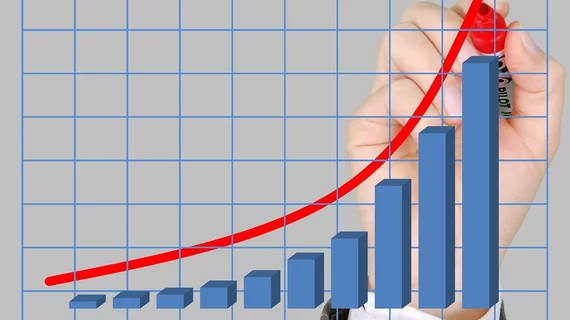RadNet says AI revenues have surged 109% year-over-year, but business line still in the red
RadNet Inc. said Tuesday that revenues from artificial intelligence initiatives have surged 109% year-over-year, though the business line is still operating in the red.
In 2023’s first six months, the Los Angeles-based imaging center operator collected $4.51 million from its AI segment versus $2.16 million during the same period last year. The proceeds come primarily from RadNet’s Enhanced Breast Cancer Diagnostic, or EBCD, service, which charges women a $60 out-of-pocket fee to have AI analyze their mammography results.
However, the publicly traded company still expects to lose money on AI in 2023. RadNet is adjusting its financial guidance, anticipating artificial intelligence will produce net revenue of up to $13 million in 2023, down from its $18 million estimate issued earlier this year. Adjusted losses, meanwhile, are projected at up to $13 million, up from an $11 million loss forecasted earlier this year.
“Though revenue is growing quickly and enrollment in our EBCD program is gaining steam, we are about 90 to 120 days behind the initial rollout schedule we set last year,” Chief Financial Officer Mark Stolper told Radiology Business following the company’s quarterly earnings call on Aug. 8. “Much of the delay is the result of us testing different service offerings and pricing in various east coast markets, as well as training our schedulers, front office personnel and technology implementations with our radiologists. We are still aiming to begin implementing EBCD on the west coast sometime in September,” he added, which is several months later than the initial go-live date.
Imaging center business booming
Meanwhile, officials said the imaging center side of RadNet’s business continues to boom. Excluding results from AI, the company recorded a “quarterly record” of $403.7 million in Q2 revenue, up 13.9% from the same period in 2022.
The imaging center segment also scored record earnings—before interest, taxes, depreciation and amortization—for the company of $63.7 million in the second quarter, up 14.7% year-over-year. EBITDA was about $60.4 million when factoring in losses from AI.
MRI volume leapt 11.8% in the second quarter compared to Q2 of 2022, while CT was up 11.3% and PET/CT 18.3%, continuing a trend of growing demand for the nuclear exam. Overall volume—which includes X-ray, ultrasound, mammography and other exams—climbed 11.4%. When comparing only the same centers that were operating in both quarters, MRI was up 7.3%, CT 6.3%, PET/CT 18.8% and overall volume 7.1%.
“In response to the heavy volume demands we are experiencing in many of our imaging center regions, we are growing capacity and access through the de novo strategy we embarked on last year,” President and CEO Howard Berger, MD, said in an Aug. 8 announcement.
RadNet said in March 2022 that it was focusing on building out brand-new centers, rather than buying existing ones. The company opened one new facility in the second quarter and is working on five more through the rest of the year, with six additional centers set to be built in 2024. Hospital joint ventures also remain active, Berger added, as the company has inked new partners and is working on expanding existing relationships.
RadNet revised its financial guidance for the second time this year, expecting to collect upward of $242 million in adjusted earnings (up from $235M) on net revenues of as much as $1.61 billion (up from $1.6B) from its 363 imaging centers.

